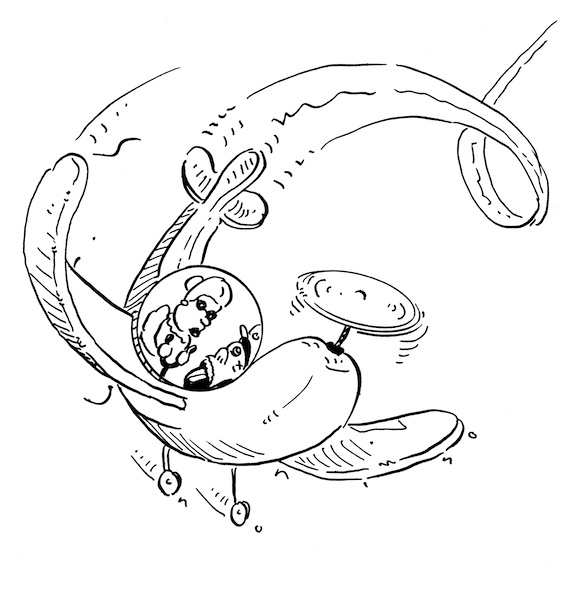
I watched the film “Turbulence” the other day. In the movie, after a shootout on a flight transporting prisoners, a stewardess must outwit a serial killer and land the airplane herself. Has it ever happened that the pilots have been incapacitated and an airplane has been landed by a flight attendant or passenger? — Bjarne Martensson, Hamina, Finland
[hr_dotted]
Well, having a little prior training seems to be extremely helpful, if not an actual prerequisite. But yes, it can be and has been done. Examples:
- In July 1985 a passenger who had flown a plane once but wasn’t certified was able to bring a Cessna safely to ground in Lansing, Michigan, after the pilot suffered a heart attack and died in midflight.
- In February 2002 a woman with just 48 hours of pilot training took the controls of a twin-engine Cessna over Cape Cod after the pilot became incoherent following an insulin reaction. Unable to reach anyone on the ground, she was able to safely crash-land the plane on the ground next to the runway, saving everyone aboard.
- In 2009 a Florida man with 130 hours of experience flying single-engine planes took the controls of a twin-engine turboprop after the pilot died early in the flight. The emergency stand-in, whose wife and daughters were also aboard, claimed later he’d had no idea how to operate the larger plane beyond working the radio, but he was successfully talked down to a safe landing.
- Last April, when her husband lost consciousness while flying a Cessna in Wisconsin, 80-year-old Helen Collins, who hadn’t piloted a plane in decades, managed to contact air traffic controllers and, with coaching, crash-land the plane without major injury. (Her husband, however, didn’t survive his medical emergency.)
OK, you say, but what about big commercial aircraft? More examples:
- In November 2008 the copilot of an Air Canada Boeing 767 suffered a mental breakdown and had to be forcibly removed from the cockpit, restrained and sedated. No other pilots were aboard, so a flight attendant with flying experience took over the copilot’s chair for an emergency landing in Shannon, Ireland.
- In June 2010 a flight attendant with 300 hours of experience flying a Cessna sat in for an ill first officer on an American Airlines 767 landing in Chicago.
- This past November a Lufthansa Boeing 747 en route from New York to Frankfurt made an unscheduled landing at Dublin after the first officer suffered a severe migraine. News reports credited a heroic passenger with helping land the plane, in a sequence of events described in the Irish Independent’s coverage as a “miracle.” However, the helpful passenger happened to be an off-duty Boeing 767 pilot, which in my book takes the incident out of the miraculous realm.
The common thread here is that the replacement pilots had some experience, and in the cases involving big commercial jets they weren’t solely (or even mainly) responsible for landing the plane. So the question remains whether an inexperienced passenger could be successfully talked down without a copilot on hand. Wussy answer: maybe.
In a 2007 episode the “MythBusters” guys tested this possibility using a NASA simulator of a commercial airliner: in the first trial they received no help; in the second a licensed pilot gave them instructions over the radio. Left to figure it out themselves, both of the show’s hosts crashed, but with instructions each was able to land the plane without simulated fatalities.
A considerable advantage when landing a commercial aircraft is that most big planes today have automatic landing capability, which relies on a combination of onboard electronics and signals from airport runway lights and transmitters. The system is meant to help pilots in cases of low visibility and can be used only under certain wind conditions. If those conditions prevail, the system is reasonably precise, with locational accuracy of two feet vertically and 13 feet laterally.
The likelihood of failure during autolanding is advertised as one in 2 billion, but that’s basically what they said about the odds of the 2008 financial meltdown. In point of fact, a Turkish Airlines Boeing 737 crashed during a 2009 autolanding at Amsterdam’s Schiphol airport, killing nine and injuring 120, due to altimeter malfunction compounded by subsequent pilot error. But let’s not panic. Chances are that most large airplanes would be able to land themselves successfully with minimal input from passengers or the remaining crew, assuming the weather cooperated.
General aviation airplanes typically aren’t equipped for autolanding, but no matter — crashes due to a conked-out pilot are rare. Reviewing U.S. records for 2010, my assistant Una found that of 472 total aviation accidents, only seven resulted from pilot incapacitation, and in only two of these was anyone else in the plane. In short, it’s highly unlikely you’re going to find yourself in this situation, and if it happens nonetheless, there’s a decent chance you’ll pull through.
— CECIL ADAMS
Send questions to Cecil via straightdope.com or write him c/o Chicago Reader, 350 N. Orleans, Chicago 60654. Subscribe to the Straight Dope podcast at the iTunes Store.
